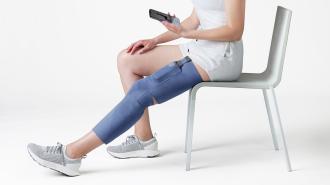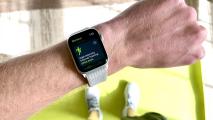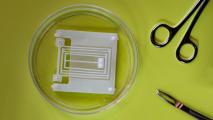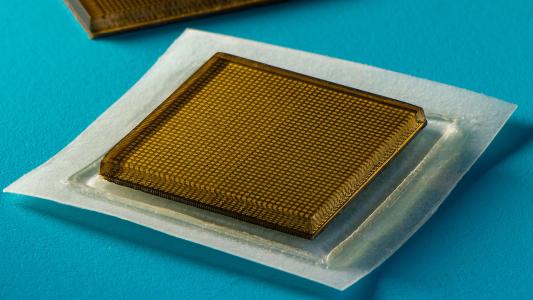An AI-powered wearable that electrically stimulates the leg muscles is helping people with mobility issues walk faster, longer, and with less pain — and it’s changing their outlook on life.
“I’m able to walk more confidently and without the added bandwidth in my brain of ‘I’m going to fall’ with each literal step,” said stroke survivor Patricia Allen. “It [is] an unparalleled sense of freedom.”
The challenge: Nearly 14% of American adults have serious difficulty walking or climbing stairs — this can not only impact their ability to live independently and enjoy a high quality of life, but also lead to falls and severe injuries.
Existing mobility aids, such as canes, walkers, and wheelchairs, are often cumbersome and unhelpful when a person needs to walk up stairs. They also immediately “out” a person as mobility impaired, opening them up to intrusive questions and social stigma.
“I was frustrated by the lack of solutions and the lack of technology to address her condition.”
Jeremiah Robison
The Neural Sleeve: For the millions of people who have difficulty walking due to strokes, multiple sclerosis (MS), and other neurological disorders, the problem isn’t that their legs are injured — it’s that their brains don’t effectively communicate with their limbs.
After watching his own young daughter battle mobility issues due to cerebral palsy, tech innovator Jeremiah Robison set out to build a better mobility aid for people like her.
“I was frustrated by the lack of solutions and the lack of technology to address her condition,” he said. “As a technologist, I had all this opportunity to bring to bear all of the amazing innovations that we’ve seen in autonomy and apply those to the human body to give her something better than crutches, canes, walkers, and wheelchairs.”
In 2018, Robison founded bionic clothing startup Cionic, and in 2022, the FDA cleared its first product — the Neural Sleeve — for market.
“It is an unparalleled sense of freedom.”
Patricia Allen
How it works: The Neural Sleeve is a flexible, lightweight device that wraps around a person’s upper and lower leg. Hidden inside its breathable fabric is a system of sensors and electrodes that communicate with an AI-powered app.
The sensors monitor the position of the leg and the firing of individual muscles in it. The app analyzes that data to predict a person’s intention to take a step 1/10 of a second before their foot leaves the ground. It then commands the electrodes to stimulate the right muscles at the right time to support a natural gait.
The trials: For their first clinical trials, Cionic tested the Neural Sleeve’s ability to help 32 people overcome foot drop. This condition is characterized by difficulty lifting the front part of the foot while walking, which makes people with it more susceptible to tripping and falling.
According to a pre-print paper released on medRXiv, the Neural Sleeve led to a statistically significant improvement in participants’ gaits by two key measures, with 94% seeing increased ankle dorsiflexion at heel strike and 88% experiencing decreased ankle inversion during swing phase.
“I haven’t used my wheelchair in over a month.”
Beverly Chaidez
To test the impact of the Neural Sleeve when used over the longer term, Cionic has been conducting trials in which people with mobility issues take a device home with them.
According to Cionic, the Neural Sleeve has reduced the number of home trial participants experiencing moderate to severe pain by 60% and the number reporting moderate to severe anxiety or depression by 75%. Many users have also reported improved mobility.
“When I started the home usability trial, I was only able to walk for about five to 10 minutes at a time, and I used a wheelchair for mobility outside of the home,” said trial participant Beverly Chaidez, who lives with MS.
“Today, I can walk for 40 to 50 minutes at a time and I haven’t used my wheelchair in over a month,” she continued. “I feel hopeful and optimistic that I can regain a lot of things that I lost.”
The advocates: Cionic’s foot drop trial was small and the data has yet to be peer-reviewed. The home usability trials, meanwhile, are ongoing, and it’s not clear when or if Cionic will publish any data from them.
Still, the device has been garnering praise from both users and medical professionals, including Jacqueline Nicholas, System Chief of Neuroimmunology and MS at the OhioHealth MS Center, who has seen the Neural Sleeve improve mobility in two of her MS patients.
“This is the first comprehensive system that addresses key muscle groups of the leg, which means it has the potential to improve mobility and function with continued use,” said Nicholas. “It’s unlike anything I’ve ever seen.”
“The Neural Sleeve has been fantastic in my recovery,” said trial participant Neale Mahon, who lost movement in his left side following a brainstem stroke. “I am able to move much faster and safer.”
Looking ahead: In July 2022, Cionic announced that it partnered with designer Yves Behar’s fuseproject to ensure the commercial version of the Neural Sleeve would be comfortable, easy to use, and something people would actually want to wear.
“It’s not designed to look like a medical product,” said Behar. “We wanted folks to be proud of it, for the Cionic sleeve to really look more like … a sports product than a medical product and also have the materiality [and] the colors that make people feel good about their recovery.”
“It has the potential to improve mobility and function with continued use.”
Jacqueline Nicholas
Those interested in the fuseproject-designed Neural Sleeve can see if they qualify for Cionic’s early adopter Explorer Program on the company’s website. If they do, they can pre-order a device, with deliveries expected in early 2023.
They’ll need to pay $200 per month for 12 months. After that, they’ll own the Neural Sleeve outright. A doctor’s prescription is required, and the device is not covered by insurance, though Cionic says it will support customers’ efforts to try to get reimbursed by their insurance companies.
While the device is currently only available for people 22 and older, Cionic is also in the planning stages for pediatric trials, with the hope of eventually helping people like Robinson’s daughter overcome the mobility issues that may otherwise prevent them from living life to the fullest.
We’d love to hear from you! If you have a comment about this article or if you have a tip for a future Freethink story, please email us at [email protected].





